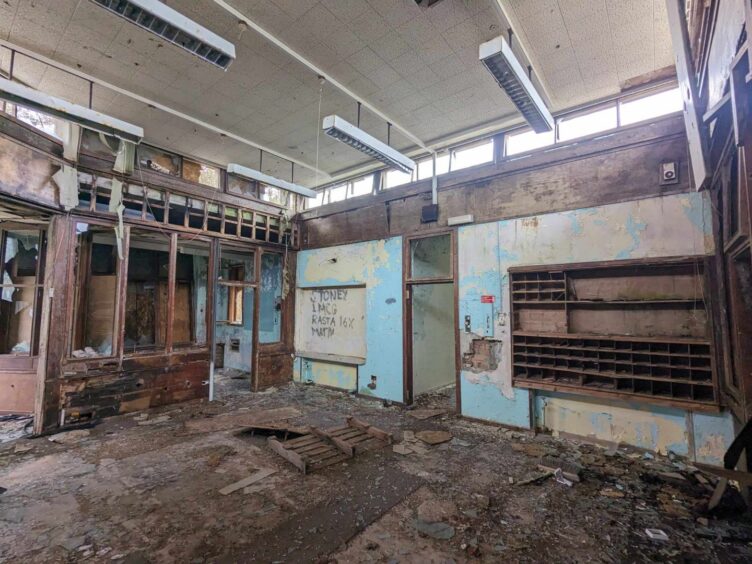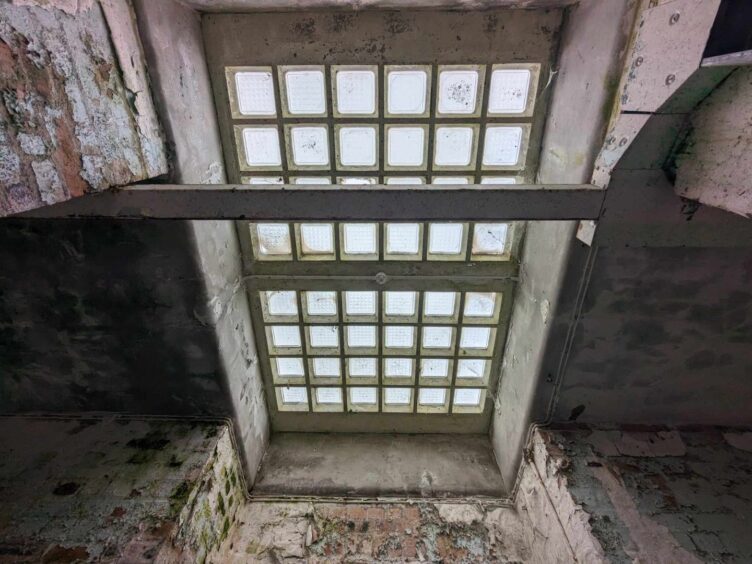It’s almost quarter of a century since Stonehaven Coast Radio Station transmitted for the very last time.
The long, low, flat-roofed building first opened in 1958 and played a vital role in the coast radio station network across the UK, operating a distress watch, handling mayday calls and coordinating rescue operations.
Time has not been kind to the rather unsightly building, which stands empty and boarded-up on a hill above the Mearns town, falling further into decay with the passing of each year.
Despite being encircled by an imposing seven foot spiked steel fence, and with signs threatening intruders of security CCTV, it’s been targeted by vandals.
The former station, which is on Scotland’s Buildings at Risk register, has, over the years, been on the cusp of having its fortunes turned around – with plans to transform it into offices, a museum, and a brewery.
Today, it’s owned by Scottish craft brewery Six Degrees North. But the Stonehaven-based business says their dreams of turning the building into a small brewery and visitor centre have been “shelved indefinitely”.
Dangerous building – do not enter
It’s not possible to enter the building since fencing – which had been partially vandalised – was reinstated, and I wouldn’t advise trying.
I visited (with permission) and found, among the smashed glass and rotting walls: wooden pigeon hole storage units; an old fire alarm system; an engine room complete with emergency generator; ragged curtains flapping in the wind; electric control panels; old fans still turning; and an industrial vacuum cleaner.
Vandals have pretty much stripped the place bare, and graffiti is splashed across walls throughout.
Pigeons flap and coo, and empty nests, blown down by the wind, lie on the mouldering floor.
There’s a creepy corridor with rooms running down both sides. Most are empty and damp with peeling wallpaper and rusting electric sockets.
Having done a bit of research, I learned that the polygonal ‘operating room’, in the style of an airport control tower, was made almost entirely out of glass.
But little glass remains, other than the smashed material on the ground.
At one point, the building boasted a ‘squat chimney’ at the north end, and 120 feet lattice steel masts. A few remain.
Key role in Piper Alpha disaster
The Piper Alpha disaster, on July 6, 1988. was one of the most dramatic and moving moments in the history of Stonehaven Coast Radio Station.
The distress call came just after 10pm. A violent blast had ripped through the structure and the mayday sent from the oil platform, 120 miles north-east of Aberdeen, was picked up by the station.
Eddie MacRae, one of the radio operators on duty that fateful night, recalled: “It was frightening. Anybody sitting at their desk and gets a message like that gets an urge of self-panic.
“You didn’t want to get anything wrong, you wanted to get as many of the facts, as dead accurate as you can.”
As the horror unfolded, Stonehaven was key in handling back-up communications between rescue and support vessels scrambled to the scene.
By the time the rescue operations stood down, 167 men were dead and 61 workers escaped and survived.
End of an era
When the station fell silent on June 30, 2000, it brought to the end an era which had begun 90 years earlier, in 1910, when the first radio station in the Stonehaven area was built three miles south at Criggie.
It was used mainly as a telegraphy station, passing messages across the country and between continents.
With Second World War hostilities ramping up, coverage of the North Sea from Cullercoats (on the Tyne) and Wick was found to be limited.
And so the admiralty built a station comprised of small wooden huts in fields up from Dunnottar Castle, opening it in May 1942. this was used for transmitting and receiving vital wartime information to and from shipping.
One hut remains, although it’s well-boarded-up.
New chapter of history
Construction of the ‘new’ station began in 1956, and there’s a stone plaque on the exterior marked with that date. It opened two years later, in January 1958.
In the post-war years Stonehaven Radio Station, call name GND, entered a new chapter of its history as a vital part of the coast radio station network across the UK, keeping a distress watch, handling mayday calls and coordinating rescue operations, working with the Coastguard and RNLI.
By this time, it had been taken over by the Post Office and was also handling the extensive commercial messages for trawlers. They sent information about big catches in code, so nobody else could translate how much fish they had caught.
By 1947 the cluster of wooden huts and masts on the fields by Dunnottar were not fit for purpose and a new station was planned – the one that stands, decaying today.
It kept distress watches on both Morse code and radio frequencies. Officers would transmit essential weather and navigational warnings to ships in their area.
The station was also the hub for commercial messages and radio links between ships and their companies, or even putting phone calls from crew members through to their loved ones in their homes.
North Sea oil exploration
As the oil industry boomed, so did the rapid need to coordinate communications in speech and radio telex – and it became a key station during the days of North Sea exploration.
Many of the oil fields were being assembled and the station coordinated link calls for crews calling home.
On some days, Stonehaven staff, working shifts to cover 24 hours a day, 365 days a year, were handling more than 700 radio link calls a day.
However, as satellite communications and mobile phone technology advanced, it became clear that the days of “steam radio” were numbered.
And so BT shut down Stonehaven Radio Station on June 30, 2000.
It was the last staffed coast radio station in the UK, controlling the entire coastline.
- Check out our full gallery of images of the derelict radio station here.











Conversation